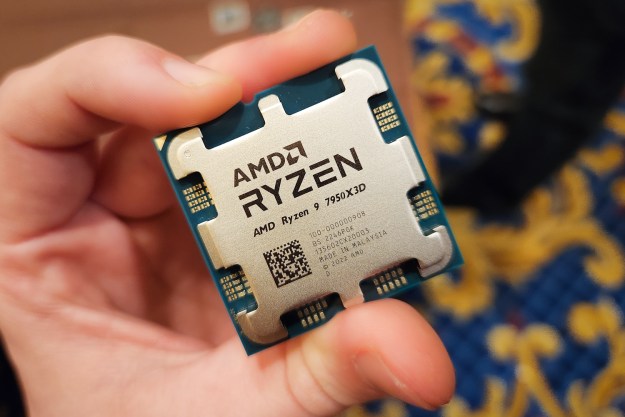Ryzen 3000 CPUs with Zen 2 cores were a landmark achievement for AMD. With AMD’s powerful Ryzen 4000 mobile processors leveraging that same architecture, the company is intensifying its competition with Intel’s laptop silicon. The goal for AMD is to release laptops that are just as powerful as they are thin using the U-series Ryzen 4000 processors, as well as performance-driven notebooks powered by beefier Ryzen 9 4900H and Ryzen 9 4900HS chips.
That’s not all that’s exciting about AMD’s Ryzen 4000 chips, though. Here’s everything you need to know about AMD Ryzen 4000 CPUs.
Pricing, release
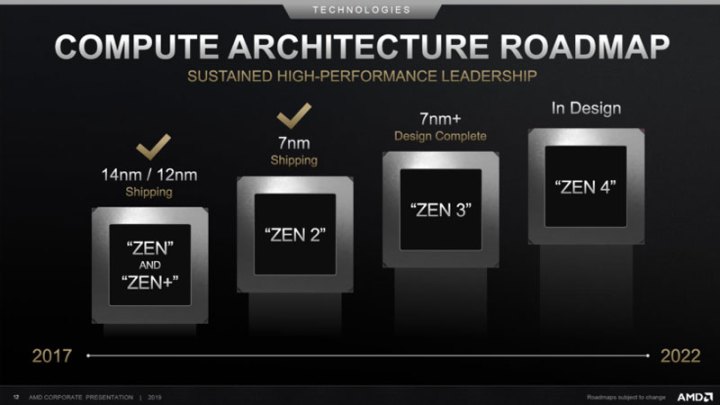
AMD debuted the first Ryzen 4000 CPUs at CES 2020, where it showed off a new generation of mobile accelerated processing units (APUs) featuring Zen 2 CPU cores (found in Ryzen 3000 desktop CPUs) paired with Vega graphics cores.
A full range of chips was announced, from the low-end to the high, and many of them are now available, at a variety of prices.
Ryzen 4000 mobile CPUs are found in a variety of laptops, from budget-conscious models for around $600, to higher-end gaming machines that reach almost $1,500. The desktop APUs tend to focus on lower-end and midrange desktop machines priced between $500 and $1,000.
Mobile gamers will be drawn to AMD’s flagship Ryzen 4000 mobile processors, including the Ryzen 9 4900H and 4900HS CPUs. Both chips are designed to take on Intel‘s Core i9 silicon in the high-end mobile gaming space.

Although Ryzen 4000 was also expected to be the name of the next-generation desktop range of Zen 3 processors, AMD confirmed otherwise in early October 2020. Those chips are known as Ryzen 5000.
Architecture
Ryzen 4000 series mobile CPUs, like the Ryzen 3000 before them, are based on the same architecture as the respective previous-generation’s desktop architecture. Ryzen 4000 mobile CPUs leverage the same Zen 2 architecture as the Ryzen 3000 desktop CPUs, though in a different manner. Where the latter used a chiplet design, with CPU cores portioned into miniature chips and paired with a larger I/O die, the Ryzen 4000 Zen 2 mobile CPUs are built using a more traditional monolithic die.
AMD claims that the benefits of the chiplet design were far less notable on a laptop CPU, and it opted to integrate more elements — like LPDDR4X and low power audio — onto its monolithic die design.
This means greater power efficiency since the I/O die isn’t present and demanding its own power. Cache is reduced, however, and there is some additional memory latency due to an uncoupling of the infinity fabric with system memory.

Zen 2 on Ryzen 4000 mobile chips is still a major upgrade over existing Ryzen 3000 mobile APUs based on the Zen+ design, though. It drops the process node size from 12nm to 7nm and has a number of architectural efficiency improvements. Similar to Zen 2 desktop chips, the first Ryzen 4000 laptops feature higher instructions per clock of 15% and increased base and boost clock frequencies.
In eight-core configurations, they are split into two CCX units, with L3 memory reduced to 4MB per CCX from 8MB on the desktop design. Thanks to a 7nm process, AMD claims that it is able to reduce power consumption on active and idle modes. That performance can aid in faster boot times, and battery life is improved in some designs too.
Performance
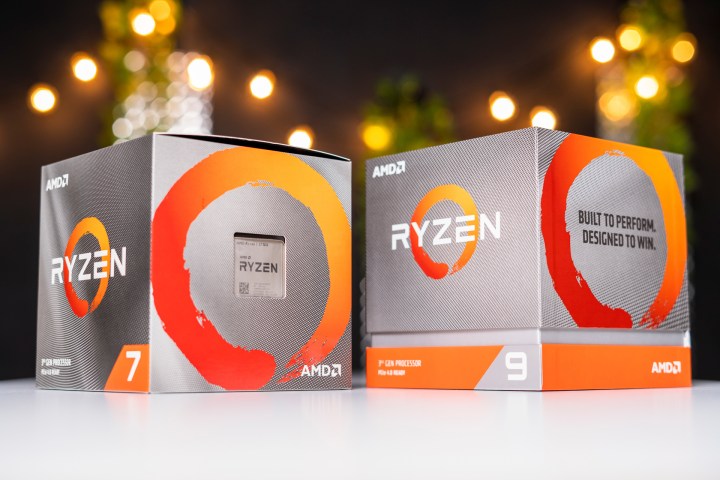
The Ryzen 4000 mobile CPUs have a significant performance uplift over their Ryzen 3000 counterparts. Desktop Zen 2 chips were a marvel, and their laptop counterparts are comparably impressive. Just look at the spec sheet.
| Cores/Threads | Base | Boost | Graphics | TDP | |
| AMD Ryzen 7 4800H | 8/16 | 2.9GHz | Up to 4.2GHz | 7 Radeon Cores | 45W |
| AMD Ryzen 7 4800U | 8/16 | 1.8GHz | Up to 4.2GHz | 8 Radeon Cores | 15W |
| AMD Ryzen 7 4700U | 8/8 | 2.0GHz | Up to 4.1GHz | 7 Radeon Cores | 15W |
| AMD Ryzen 5 4600 U | 6/12 | 2.1GHz | Up to 4.0GHz | 7 Radeon Cores | 15W |
| AMD Ryzen 5 4600H | 6/12 | 3.0GHz | Up to 4.0GHz | 6 Radeon Cores | 45W |
| AMD Ryzen 5 4500U | 6/6 | 2.3GHz | Up to 4.0GHz | 6 Radeon Cores | 15W |
| AMD Ryzen 3 4300U | 4/4 | 2.7GHz | Up to 3.7GHz | 5 Radeon Cores | 15W |
| AMD Ryzen 3 3250U | 2/4 | 2.6GHz | Up to 3.5GHz | 3 Radeon Cores | 15W |
With multithreaded performance, the six and eight core Ryzen designs give content creators serious power over laptops with a quad-core design. In early first-party benchmarks from AMD, video encoded 40% faster on the Ryzen 4000 than on Intel’s quad-core Core i7-10510U. Strong multithreaded performance makes Ryzen laptops powerful mobile workstations, with AMD closing in on Intel’s lead in single-core performance. AMD’s test using the Cinebench R20 tool showed a 25% improvement in single-core performance compared to the prior generation while still using 15W of thermal design power.
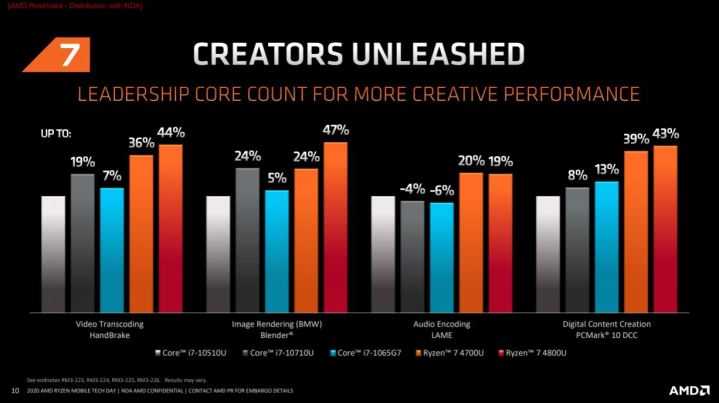
This played out in release hardware too. Our review of the Lenovo IdeaPad Flex 5 14, a relatively budget-focused laptop, showed it to be an absolute powerhouse for just $600, demolishing the more expensive Intel counterparts in multithreaded workloads. For just a couple of hundred dollars more, you can get the Acer Swift 3, with eight CPU cores and the kind of performance we typically expected in $2,000-plus laptops like the MacBook Pro 16.
AMD’s traditionally strong onboard graphics are present once again with this generation. The Vega graphics design may be a few years old — it’s based on the aging GCN architecture rather than AMD’s newer Navi designs — but improvements on the 7nm process node have increased its power by almost 60% over the last-generation counterparts in some games.
That aside, the best examples of Ryzen 4000 gaming laptops do leverage a dedicated GPU. The Asus ROG Zephryus G14 and Dell G5 SE show AMD laptops are no longer lackluster for gaming, but in fact easily competitive with comparably priced Intel models. Intel’s Tiger Lake laptops should steal the gaming performance crown when no dedicated GPU is present, but if you have a graphics chip too, AMD quite often pulls ahead.
Ryzen 4000: Desktop
Ryzen 4000 desktop CPUs are exclusively accelerated processing units, or APUs, bringing discrete graphics and Zen 2 cores to the CPU space in a single package. AMD renamed its next-generation Zen 3 desktop CPUs to Ryzen 5000 just before their debut in early October 2020. You can find more about them, here.
The Zen 2-based Ryzen 4000 processors start with the Ryzen 3 4300GE, which comes with four cores and eight threads and a base clock speed of 3.5GHz, and scale all the way up to a Ryzen 7 4700G, with a 4.4GHz boost clock, eight cores and 16 threads, and eight integrated graphics cores.
The consumer line is split between the GE series, which requires 35W TDP, and a G series, which requires 65W TDP. The GE series include the Ryzen 3 4300GE, Ryzen 5 4600GE, and Ryzen 7 4700GE, while the G series include the Ryzen 3 4300G, Ryzen 5 4600G, and Ryzen 7 4700G.
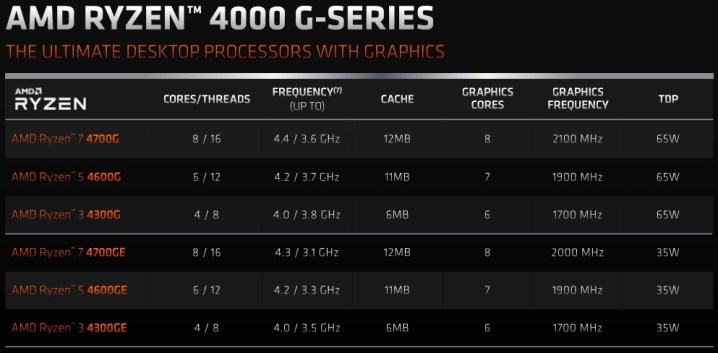
Additional variants of these CPUs include the Ryzen 3 PRO 4350G, Ryzen 5 PRO 4650G, and Ryzen 7 PRO 4750G at 65W TDP, and the Ryzen 3 PRO 4350GE, Ryzen 5 PRO 4650GE, and Ryzen 7 PRO 4750GE at 35W TDP.
These processors are, for now, only available in prebuilt PCs, so you can’t upgrade your existing desktop to a Ryzen 4000 APU.
Like with their mobile counterparts, AMD is promoting the strong graphics performance of these processors. The strength of the integrated GPU makes it possible to play some games at lower detail settings without a discrete graphics card.
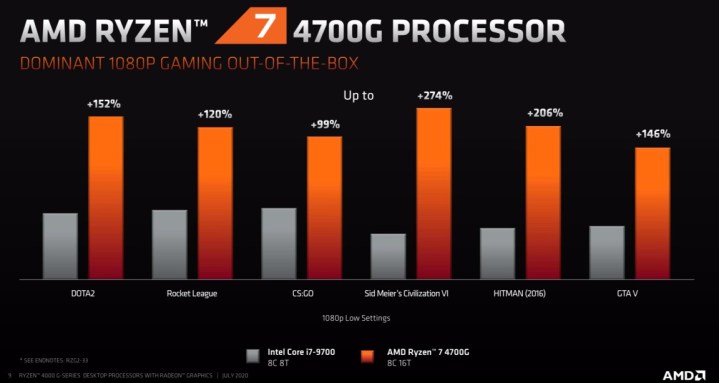
AMD’s early internal benchmarks showed a boost between 99% and 274% in popular games when compared against Intel’s Core i7 9700 processor. Real-world reviews suggested similarly excellent performance, with chips like the 4700G offering the best integrated graphics performance of any CPUs out there.
There aren’t really comparable to even entry-level gaming GPUs, but low-budget gaming on a Ryzen 4000 APU is certainly possible.
General compute performance isn’t as strong as Ryzen 3000 Zen 2 desktop CPUs, but it’s not far off either, making these chips excellent competitors for last-generation Intel CPUs and some of the more entry-level models from the 10th-generation.
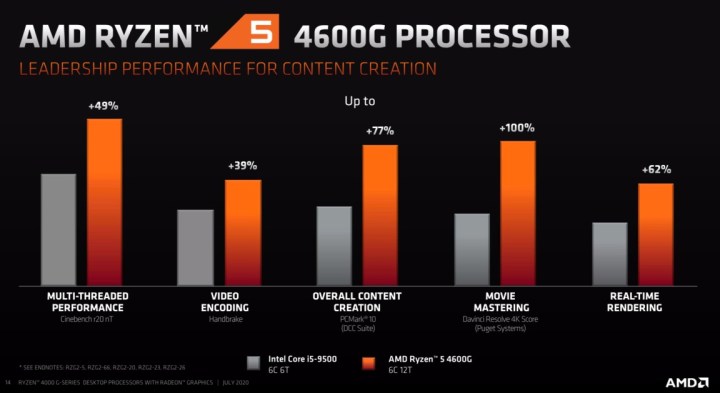
Editors' Recommendations
- AMD Zen 5: Everything we know about AMD’s next-gen CPUs
- Everything you need to know about buying a GPU in 2024
- What is VSync, and why do you need it?
- AMD is making the CPU more and more obsolete in gaming
- The best motherboard for the Ryzen 7 7800X3D is cheaper than you think



